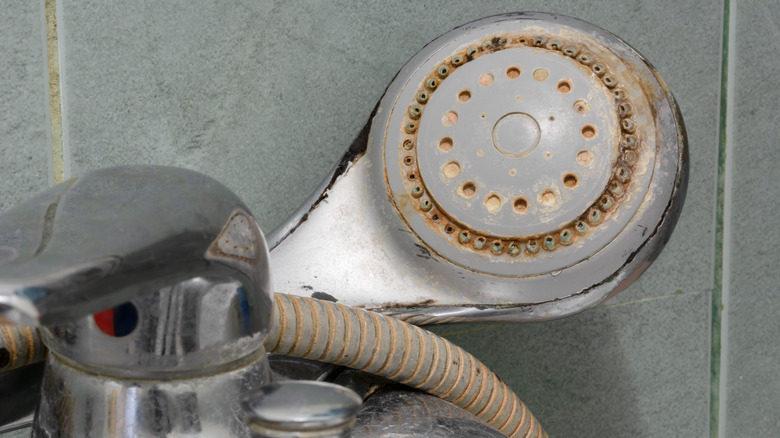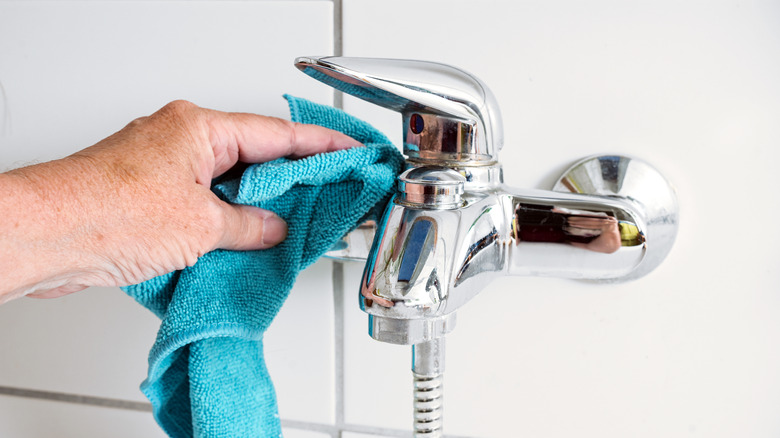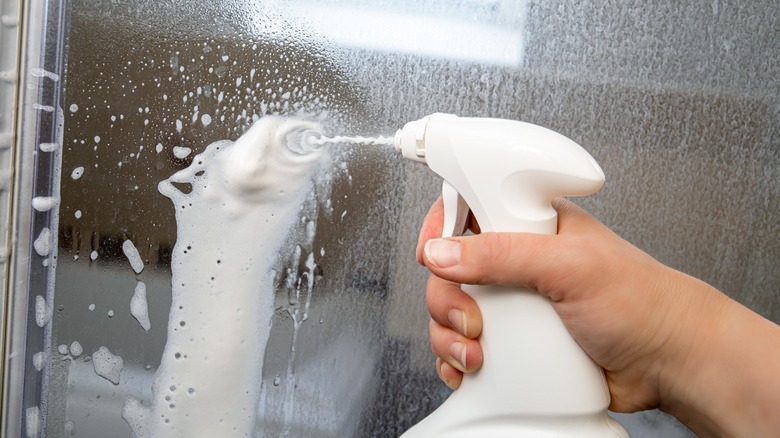The Household Staple That Makes Removing Limescale Even Easier
We may receive a commission on purchases made from links.
If you've been noticing a buildup of chalky deposits on surfaces in your bathroom or kitchen where you frequently use water, you may have a buildup of limescale, aka calcium carbonate. This buildup is unsightly, so you'll want to clean it quickly. There are plenty of limescale remover products on the market, which you apply to the areas where the white or red chalky substance appears, but they can be expensive. You'll pay around $28 per gallon for a well-known brand name in a removal product at Amazon, for example. A better option is a household product you may already have on hand — hydrogen peroxide.
Limescale builds up on your appliances because of hard water, which is a problem in 85% of the United States. Hard water contains minerals like magnesium and calcium. When the water evaporates, it leaves these minerals behind, creating a chalky buildup. Anywhere that may have a little bit of water left behind after you use it, such as at a toilet, kitchen faucet, sink, and shower head, could end up with a limescale buildup as a result.
Calcium carbonate consists of one atom of calcium, one atom of carbon, and three atoms of oxygen. When you apply an acidic substance to the calcium carbonate, such as hydrogen peroxide, it creates a chemical reaction that converts the compound to a metal salt that is dissolvable in water. You then can simply wash it away. Hydrogen peroxide is a relatively weak acid, but it still works to eliminate limescale, making it an easy, cheaper option.
How to remove limescale using hydrogen peroxide
You can deploy hydrogen peroxide to remove limescale in a few different ways. First, you can use a household concentration of this liquid, which is 3%. You shouldn't need 35% concentration of hydrogen peroxide, such as those used in food-grade applications since the 3% solution will work fine for cleaning limescale. You can purchase a 32-ounce bottle of 3% hydrogen peroxide for just $1 at Walmart, although many people will have this substance on hand already. Be careful even when using 3% hydrogen peroxide, though, since it can cause respiratory issues, as well as pain and irritation with eye or skin contact.
One of the easiest options is to simply place the hydrogen peroxide in a spray bottle and douse the areas that have stains and any chalky buildup. Let the spray sit in place for anywhere from 15 to 30 minutes before wiping it away with a damp sponge or microfiber cloth. This is a great method to use on a large surface space, such as a shower door or a faucet.
If you have a particularly tough limescale issue that is not resolved by simply spraying and wiping it, you can add baking soda to create a paste. Mix half a cup of baking soda and five to eight tablespoons of hydrogen peroxide. Apply the paste to the area with the significant staining from calcium carbonate. Let it sit for 30 minutes. Then, scrub it with a soft-bristled brush and rinse the area thoroughly before wiping any residue away.
How to prevent limescale from appearing in your home
If you want to avoid limescale building up in various areas of your home, installing a water softener is the best option. This is important because, beyond the limescale that you can see on the surface of faucets, there could be additional buildup in areas that you cannot see. Having calcium carbonate could damage your plumbing alongside the appliances that use the hard water, such as a dishwasher or washing machine.
Such issues could even lead to hard water creating an unseen horror in your home, meaning your appliances wear out far earlier than expected. A dishwasher with an expected 10-year lifespan may only last seven when limescale is building up without a water softener installed, for example. Hard water can have a significant effect on a toilet, too — especially on the parts in the tank itself — dropping the projected lifespan from 6.5 years to just two.
Consider keeping a spray bottle handy with a mixture of hydrogen peroxide, water, and dish soap. Spray down the shower door or use the mixture on your shower head and faucets several times a week. Let the spray sit for a few minutes before wiping it off with a microfiber cloth. Regularly removing limescale can help reduce the frequency of having to do a more thorough cleaning with hydrogen peroxide in the future too.


